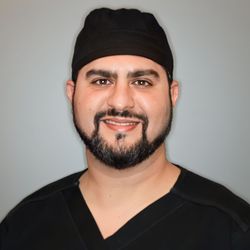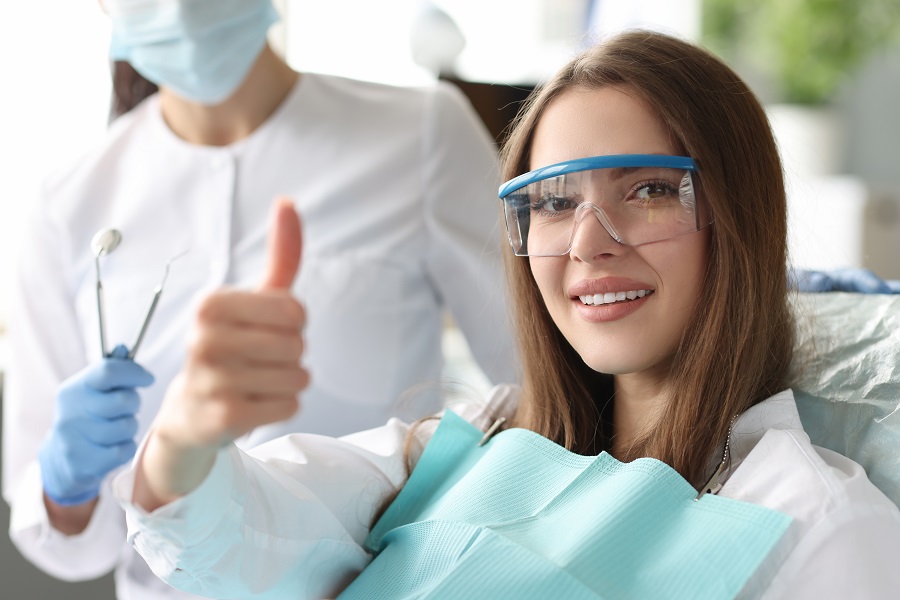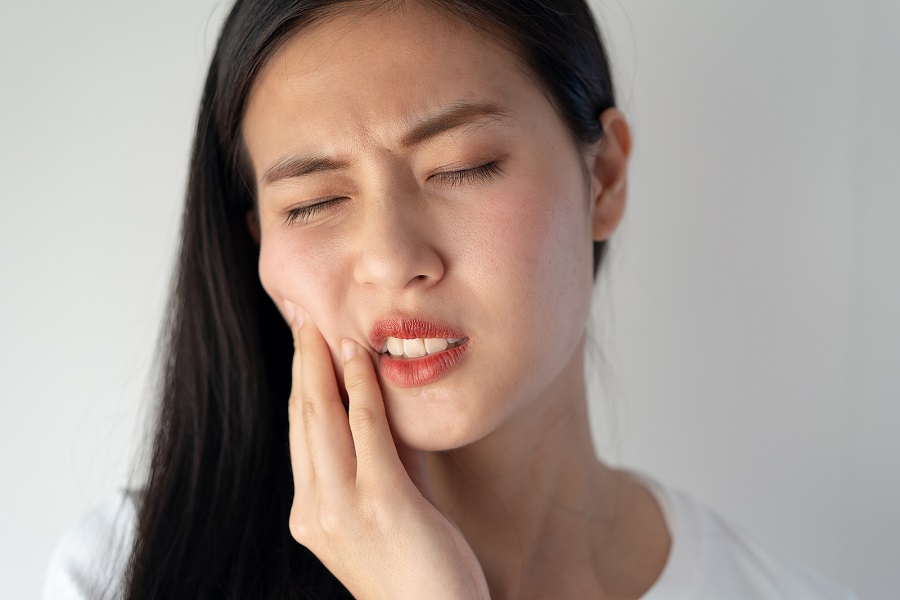If you’re one of the thousands of people in The Woodlands, Conroe, or surrounding areas to be diagnosed with and recover from COVID-19, there’s a good chance that you might also be one of what the medical community is now referring to as “long haulers”. That is someone with lingering symptoms and side effects well after the typical window of illness from the novel coronavirus
Although we’re still learning about side effects from COVID, dentists have spotted a similarity in the viral infection and changes in oral health for several months now. Some oral complications of COVID are more common than others, while certain symptoms may be a bit rarer.
Are you one of the people who didn’t have dental problems until COVID? The reassuring news is that you’re not alone. Understanding what to look for, other factors that may come into play, and what you can do to treat the symptoms — if possible — can make daily activities a bit less frustrating.
Here are just a some of the examples of post-covid oral health complications you might experience:
Inflammation Inside of Mouth After COVID
It’s not just gingivitis. People with COVID-19 tend to have specific types of cytokines inside of their mouth — which can be aggravated by periodontal disease — resulting in the perfect storm for oral inflammation. So much so, that some researchers feel that having active, untreated periodontal disease could potentially contribute to the severity of a COVID-19 infection.
Any time our body experiences inflammation — regardless of which area it is — we know that we’re experiencing some type of a response from our immune system. As antibodies rush to the area to ward off infection, the tissues become inflamed and red due to the increase in blood flow. That’s why people with red or swollen gums typically see an increase in bleeding and tenderness. Those tissues are extremely delicate and possibly even a bit thinned out, due to the swelling that is taking place.
One of the reasons why this oral symptom of COVID is so significant is that inflammation inside of our mouths can also reflect overall strain to our body as a whole. We already know that active gum disease puts us at a higher risk for respiratory disease, stroke, and heart attack (among other medical conditions.) When you throw something like COVID-19 into the mix, it becomes even more life-threatening.
If you’re someone who is considered high risk and are going out of your way to remain especially “COVID safe” by distancing, mask wearing, vaccinating, etc., then don’t overlook your mouth. Active oral infections like periodontal disease put you at a higher risk of requiring hospitalization due to COVID.
Fortunately, our periodontist in The Woodlands provides advanced gum therapy options to help people overcome their gum disease. So not only do you get to take steps to save your smile, but you could also potentially be saving your life at the same time.
Coronavirus Mouth Sores and Ulcers
In a study of COVID patients who had been hospitalized due to illness, just over 80% of them exhibited some type of oral sores or symptoms as long as three months after they had been released from the hospital
One of the things we know about COVID-19 is how it attacks the respiratory system and airway. The mucosal linings extending through the airway and up into the nose and mouth are, by proximity, also susceptible to lesions such as sores and ulcerations. But the severity of the ulcers tends to vary, with some people not experiencing any types of oral symptoms while others report aggressive and painful cancer-like ulcers.
Traditional-looking ulcers aren’t the only types of sores or irritation that have been found inside of people’s mouths who have coronavirus infections. In some studies, people have also experienced burning mouth syndrome and loss of papilla on the tongue (papilla are the small, finger-like protrusions that cover the tongue surface.) If you’ve ever heard of “geographic tongue”, where there are raw-like or “bald” patches on the tongue, depapillation is similar.
A condition called “cheilitis”, which is a type of cracked, sore area at the corners of the mouth, was also found in individuals who had suffered from a COVID infection. Typically, we see cheilitis in patients who may be immunocompromised or are developing some type of an oral thrush infection.
What scientists have found is that oral sores seem to be more prevalent in COVID patients who have suppressed immune systems, as opposed to those who are typically very healthy. The sores can occur practically anywhere inside of the mouth, including along or underneath the tongue, in the palate (roof of the mouth), gums next to teeth, or the lips.
Any time you have an oral sore or some type of ulcer that doesn’t seem to heal within two weeks, you need to have it evaluated by a professional. Assuming you are negative for COVID and not exhibiting any other symptoms, it’s best to plan an oral cancer screening with your dentist. Since sores that do not heal are a red flag for cancerous tissues, it’s essential to get screened early and regularly. Earlier diagnosis of mouth sores caused by cancer means you’ll have access to less invasive, more proactive treatment. It’s crucial to rule out the possibilities by having a professional exam and biopsy.
Xerostomia (Dry Mouth) from COVID-10
For some reason, people are seeing an uptick in dry mouth symptoms during the COVID-19 pandemic. There could be many reasons for this. One of them being that the virus inhibits saliva production at the source of your salivary glands. Another is that people tend to be a bit heavier on their “mouth breathing” because of spending months wearing masks while they’re out and about.
Regardless of the reason for your dry mouth, chronic xerostomia can put you at a significantly higher risk for red, irritated oral tissues, bad breath, and more specifically, tooth decay. Your body relies on healthy amounts of saliva to chew and digest food, as well as lubricate your teeth as it “washes” them throughout the day. Heavy saliva flow doesn’t replace brushing and flossing, but the lack thereof can lead to obvious side effects inside of your mouth.
When there’s a lack of saliva, it causes an overall imbalance in your normal oral flora. Although we typically talk about bacteria being a “bad” thing, your mouth still needs good types of bacteria to stay healthy. Xerostomia can contribute to an atypical number of good or bad bacteria inside of your mouth — and when combined with a suppressed immune system — can cause an overgrowth of bacterial colonies. In turn, it’s not unheard of to develop candida or yeast-type infections, more often referred to as “oral thrush.” Fortunately, there are prescriptions that you can take for candida infections, but the better long-term solution is to address the underlying condition that’s setting you up for thrush, to begin with.
If you have been taking prescription or over-the-counter medication, be sure to provide our periodontist with a list. Many medicines include dry mouth as a side-effect of taking them. Although it may not be ideal to quit taking certain prescriptions, we can at least take steps to minimize the impact it has on your mouth. And in a worst-case scenario, you can talk about switching to a different type of drug at the direction of your medical provider.
Xerostomia treatments can range from artificial saliva drops to moisturizing mouthwashes and toothpaste. Although some of these products can leave you with a bit of a slimy-like texture, the added lubrication makes it easier for your oral tissues to move about throughout the day without added restriction. The key is to find a brand that you like and to use it regularly.
Sipping on water throughout the day can also be extremely helpful for people with xerostomia, whether or not it is caused by COVID. Tap water is best since it has regulated fluoride levels. Bottled water may not, and some brands even tend to be a bit acidic on the pH scale. At this point, if you’re battling chronic xerostomia, every little bit of fluoride helps, so try to use a refillable water bottle that you can keep at your desk. On that note, consider supplementing with a fluoride rinse (such as ACT) or ask our periodontist to prescribe an at-home fluoride gel to use each night. Make sure you’re keeping up to date with regular checkups and cleanings so that any new areas of demineralization or decay can be intercepted as early as possible.
If your low saliva flow has coincided with a lapse in dental care, now is the time to act. A lot of people got behind on their preventative dental appointments because of pandemic closures. But through prevention, regular assessments, and the incorporation of fluoride, you can help to preserve healthy tooth enamel before rampant decay begins to kick in.
Loss of Taste
A report from the American Dental Association states that we’re seeing a loss of taste sensation as long as six months post COVID infection in some patients. Time will only tell if the symptoms can persist for longer than that.
An interesting note is that the ADA also reports that people who have a loss of taste also seem to have the viral strain present in their saliva. In other words, people with loss of taste might be unknowingly carrying the virus in their saliva and thereby be spreading it to other people who they kiss, share food with, or happen to be within range of micro-droplets coming from their mouth. But there is good news! People with COVID antibodies may have them present inside of their saliva as well, giving them an advantage against potential reinfection, should the viral strain make its way into their oral cavity. Although there’s no way to know yet how long the antibodies will be there, the most recent research has found them up to three months after patient recovery.
As of yet, we don’t really know how long it can take for people to get their sense of taste back after COVID. Some do immediately. Others experience altered taste (and smell) sensations for months. Or it might be that those were the only symptoms they experienced at all, even if their tests came back inconclusive.
The loss of taste may have something to do with the coronavirus invading the nervous tissues that feed the mouth, nose, and other parts of the face. Which would explain why the loss of taste and smell typically occur together. We as a dental and medical community can only hope that as the virus fades away, sensations of taste will be fully restored.
Are “Broken Teeth” Due to COVID?
Aside from the loss of taste and the occurrence of ulcers and mouth sores, people are also complaining of tooth damage. Although teeth are extremely durable (they’re the hardest thing in your body, after all) they don’t typically react to irritating stimuli the same way that gum tissue does. So, if COVID causes problems with teeth, why is it happening?
It turns out that tooth damage from COVID — such as broken teeth, cracked enamel, and chipped areas — might be the side-effect of a side-effect. A trickle-down result of COVID, so to speak.
Cracked teeth can be caused by things like old, outdated dental work that needs to be replaced. Or active tooth decay that isn’t treated early enough before it spreads deeper into the tooth. If you weren’t able to see the dentist during the pandemic shutdowns, it’s quite possible that leaky fillings weren’t caught in time, or that smaller cavity you needed to have filled turned into a bigger issue than it originally should have been. But that’s not the only reason…
…Cracked teeth can also be caused by bruxism, which is the term we use for chronic teeth clenching and grinding. And what’s one of the biggest causes of bruxism? Stress. Now we put the two and two together. All of the stress caused by the pandemic — whether it was losing a job, supervising our children’s schooling at home, dealing with health struggles, or simply being away from our friends — caused most of us to build up tension in our bodies in some way, shape, or form. Some of us take that tension out on our mouths. Even if we’re not clenching and grinding in the daytime, we may be doing it while we sleep. You can tell if you’re suffering from nighttime bruxism if you wake up the next morning with a headache, sore jaws, sore teeth, etc. Then one day, all of a sudden, one of your teeth breaks. Or they just start to look worn overall.
When you have a combination of both bruxism and old dental work or cavities, the side effects can be severe. It may seem as if suddenly all of your teeth are starting to break and crumble. Even if you never had issues with them in the past. Even though it wasn’t technically COVID that did this to you, it wouldn’t have been a problem if we weren’t in the middle of a pandemic, to begin with. It’s the trickle-down side-effects, rather than the virus itself, that may be causing your broken teeth.
Investing in a night guard or bite splint is a great way to protect your healthy tooth structure. But if you know you have aged dental work that needs to be changed out or cavities that have gone untreated, time is of the essence!
Facial Pain
Along the lines of “things not working” inside of your mouth — like the loss of taste or decreased saliva production — there’s another anomaly that some people experience: reduced facial muscle tone. In other words, the jaws, cheeks, and lip muscles or those immediately around them were fatigued and weak. Some of the people who saw poor muscle tone also complained of facial pain or had irregular TMJ function.
While atypical TMJ movement and facial pain may seem like two completely unrelated issues, they share a common factor: the “trigeminal nerve.” That’s the main set of nerves running through the facial areas of your TMJ, teeth, saliva glands, jaws, etc. So, if there is some type of a neuralgia experience where the nerve tissues are creating pain, you might see a mixture of oral and facial symptoms together. Be it loss of taste, oral sores, or TMJ and facial pain.
If you’ve ever heard of the condition called “trigeminal neuralgia”, you’re already aware that the nerve tissues that run through the face — which are sensitive to the COVID virus — can cause significant facial pain when they are damaged. Although typically the symptoms are caused by something like multiple sclerosis, a swollen blood vessel, tumor, or some type of traumatic injury. At this point, we can’t rule out the chances of coronavirus also affecting facial nerve tissues as well.
TMJ Pain from COVID-19?
Any time we see an increase in broken or worn-out teeth from bruxism, it’s natural to see an uptick in TMJ pain. When you’re living in the middle of a pandemic and experiencing the highest level of stress you’ve ever encountered, It’s not a surprise to have TMJ pain flare-up in the midst of it. And in this case, we’re not talking about facial pain caused by damage to your trigeminal nerve tissue, but rather that which is specifically isolated to your jaw joints.
Not everyone with TMJ pain has TMJ disorder (TMD/TMJD). But if your TMJ issues go untreated for too long, you can definitely develop a chronic case of TMD.
Typically, stress-induced TMJ pain comes from the constant clenching and tension of your jaw joints. In turn, all of that tightness radiates into the surrounding muscles and structures. Some of the most common symptoms to experience will include:
- Headaches
- Earaches
- Neck and shoulder pain
- Popping or clicking in your jaws
- Flat, worn teeth
- Sore jaws
- Broken dental work
- Limited range of motion
Sleep apnea can also cause TMJ flare-ups. If you already suspect that you have a sleeping disorder — especially with the onset of a stressful pandemic — and also see symptoms of jaw pain, you may have a bigger issue going on. Any time our body is deprived of oxygen while it’s sleeping, a natural reaction is for our jaws to tighten up and tense the TMJ. When this scenario happens night after night, it can lead to chronic TMJ pain that lasts all day long.
Although there are several other reasons why a person can develop TMJ disorder, it’s the TMD that’s brought on by stress that may be “due” to COVID. Yes, you could say the pandemic was the underlying cause of your jaw pain, but it might not have been what physically caused your TMJ issues; it was likely the stress of it that did.
Treatment for TMJ disorder can range from warm, moist compresses and massage, to bite splints or orthodontic therapy. By creating a harmonious relationship between your upper and lower teeth and reducing joint tension, we can allow for natural relaxation of your TMJ and the surrounding muscles. Sleeping in a nightguard or wearing a bite splint while you’re working during the day can be extremely beneficial. When your jaw isn’t fully engaged at times of stress, the joint and adjacent muscles naturally relax more than before.
Dental Treatment After COVID
We have a board-certified periodontal expert who specializes in soft tissue therapies related to oral disease. His experience working with individuals with chronic underlying illnesses and secondary medical concerns alongside periodontal infections means we’re able to better provide specialized gum care for individuals coming from unique health backgrounds. Our office incorporates a variety of technologically advanced treatments (such as laser therapy) to unique care approaches that allow for improved wellness — both inside of your mouth as well as your overall body.
Don’t let COVID strip you of your smile. Contact our periodontist in The Woodlands today to request a consultation.














